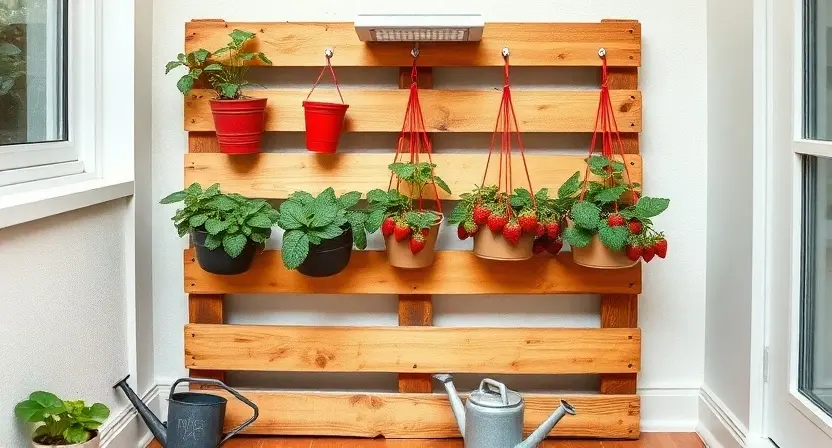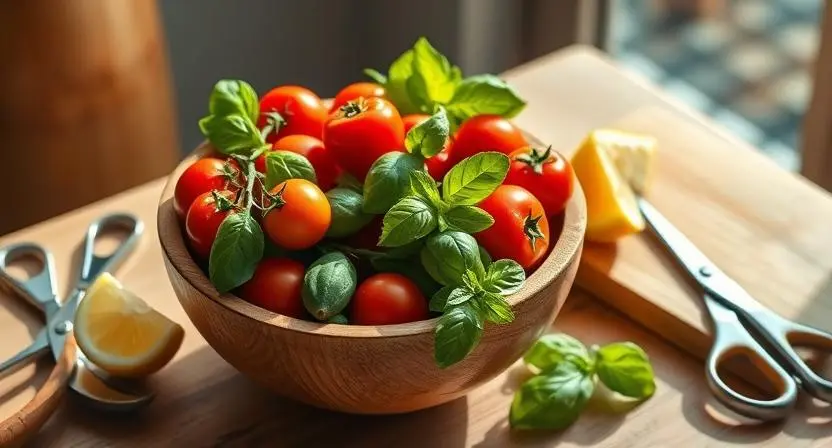Creating a small-space edible garden is highly achievable and provides significant personal and nutritional rewards. This comprehensive resource covers every aspect of small-space gardening, from planning and container selection to maximizing sunlight and troubleshooting common issues.
Why Small-Space Edible Gardening Matters
People think that only those with large backyards or plots in the suburbs should be able to garden. However, urban life has spawned a new trend, the cultivation of food in limited spaces. People are planting edibles on window sills and in their kitchen counters, on their balconies and their rooftops; everywhere they are learning that edible plants do not require acres of land to grow well.
Small-space gardening transcends the need for large plots, making fresh, homegrown produce accessible to anyone, regardless of living situation. Small-space edible gardening also offers high sustainability, reduces the need for frequent trips to the store, and provides the guarantee of chemical-free, homegrown edibles.
Mental health is another reason. Research indicates that plant tending lessens stress and anxiety and elevates happiness. Tending to herbs or chili peppers after a workday provides a soothing, productive break from daily stress. Also, engage children, and it becomes a family affair that helps instill responsibility, patience, and closeness to the natural world.
Planning Your Small-Space Edible Garden
Before you get down to planting, you need to plan. One of the most frequent mistakes that beginners commit is to purchase any random seeds and pots without thinking about space, access to sunlight, and compatibility of the plants. We can deconstruct the basics of planning.
Assess the space you have at first. Is it a balcony, a windowsill, a corner on the roof, or even a vertical wall? Note its size–you will find you are glad when you decide what to put into and what to keep out. Next, observe sunlight. The majority of edible plants require 4-6 hours of direct sunlight per day, although some greens, such as spinach and lettuce, have been able to survive in partial shade.
Establishing a clear goal, such as aiming for a weekly salad harvest or focusing solely on herbs, is crucial for maintaining motivation and guiding plant selection.
Lastly, sketch a rough layout. Sketching a rough layout helps visualize where pots, shelves, or hanging planters will be placed, which is essential to avoid crowding in small gardens.

Choosing the Right Plants for Small Spaces
The most thrilling aspect of starting a small-space edible garden is deciding what to plant. However, not every plant can be planted in small spaces. The secret is to select small, quick-growing, or vertical-growing plants.
Best Herbs for Small Spaces
The least difficult entry is through herbs. They do not need much space, multiply fast, and provide immediate flavor to foods. Basil, mint, coriander, parsley, chives, and thyme all do well in pots. Basil and Mint are highly recommended starting herbs as they are forgiving of common beginner mistakes and recover easily from minor stress.
Superior Vegetables in Containers.
Veggies such as cherry tomatoes, peppers, lettuce, spinach, radishes, and bush beans can be stored in containers. They do not require deep soil, and they grow well in cramped places. A single plant grown in a medium-sized container can yield a surprisingly large basket of cherry tomatoes, showcasing the potential of container gardening.
Compact Fruit Options
You can attempt dwarf fruit plants such as strawberries, lemons, or figs, if you are ambitious. They require a little more space and may prove to be very fruitful. One of my neighbors has strawberries as hanging baskets, and her kids have fun picking them off the plant.
Below is a comparison table to help in selecting the plants in a jiffy:
| Plant Type | Best Choices | Why is it Suitable for Small Spaces |
| Herbs | Basil, Mint, Coriander | Fast growth, small pots |
| Vegetables | Cherry Tomatoes, Lettuce, Spinach | Compact roots, high yield |
| Fruits | Strawberries, Dwarf Lemon, Fig | Grows in pots, long-term reward |
Picking the Perfect Containers
In the case of small-space edible gardens, the container you use to plant the garden is just as significant as the plants in the garden. Choosing the correct container size is critical for plant health; attempting to grow deep-rooted plants like tomatoes in a shallow pot can lead to disastrous results. Containers influence the health of the roots, water drainage, and the general growth.
Container Materials
Clay pots are traditional, yet they dry easily. Plastic pots have a longer holding capacity of water, but they tend to become overheated when placed in direct sunlight. Fabric grow bags are a game, they are lightweight, breathable, and have roots. Old buckets and wooden crates are practical and economical choices, providing a unique, rustic appeal when repurposed.
Container Size Matters
General rule: the bigger the container, the healthier the plant. The herbs can be planted in 68-inch pots, whereas tomatoes and peppers require 1218 inches. Roots are crowded in small containers, and they are not able to grow. Allow the plants to breathe.
Hanging and Vertical.
Where floor areas are minimal, consider using the vertical. Install wall-mounted shelves, shelves on hangers, or suspended shelves. Utilizing vertical space is crucial; installing a simple wooden shelf or dedicated planter stand attached to a wall can immediately increase planting capacity. Trailing herbs, including mint and strawberries, are well hung in planters.
Soil and Fertilizer Basics for Small Gardens
Any edible garden is built upon good soil. It is even more important in small containers since plants are wholly dependent on the kind of soil mixture you give them.
The Ideal Soil Mix
Do not use ordinary garden soil, it is heavy and forms easily in the pots. Rather, use a light potting mix. An ideal soil mix should be light and well-draining. A recommended composition is 40% coco peat, 30% quality compost, and 30% perlite or coarse sand. This combination provides drainage, nutrients, and aeration.
Fertilizer Choices
The small containers contain fewer nutrients, and hence plants die quickly. Liquid fertilizers, such as diluted seaweed solution or organic vermicompost tea, are effective boosters. It is often recommended to apply liquid fertilizer every two weeks during the primary growing season.
The following is a basic comparison of soil and fertilizer:
| Element | Good Choice | Why It Works |
| Soil | Potting Mix (Coco peat + Compost + Perlite) | Light, drains well |
| Fertilizer | Organic Compost, Liquid Seaweed | Safe, boosts growth |
| Additives | Crushed Eggshells | Adds calcium, prevents rot |
Sunlight and Watering Hacks
Two of the aspects that beginners fail at are light and water. Excess and deficiency are both damaging to plants, particularly in small containers.
Maximizing Sunlight
Track your sun exposure. The south-facing windows and the balconies tend to receive the greatest amount of light. When there is a shortage of sunlight, choose shade-loving plants such as lettuce or mint. Reflecting surfaces can be highly useful; placing aluminum foil or a mirror behind indoor plants, for example, can redirect light and significantly boost growth. Small grow lights are worth the cost in extremely dark areas.
Smart Watering
The leading killer of container plants is overwatering. Look at the soil prior to watering. Put your finger one inch; then, when it is dry, water. If it’s damp, wait. Self-watering containers are a savior, and more so to busy people. Self-watering containers are excellent tools for busy individuals, as they significantly reduce the frequency and stress of daily watering.
Creative Space-Saving Ideas
Small-space edible gardens are beautiful because of imagination. Even the smallest place can be transformed into a small farm using clever tricks.
- The construction of vertical gardens may be done using pallets, wall pockets, or piled crates.
- Strawberries, mint, and trailing herbs are particularly good in hanging baskets.
- Tiered: Use kitchen racks (or shoe shelves) as shelves with plants.
- Companion planting: Plant quick-growing herbs beneath the taller plant, such as peppers.
Consider combining techniques, such as cultivating lettuce on shallow windowsill trays while utilizing hanging baskets overhead for strawberries. This stacking approach creates a picturesque mini-garden that yields food year-round.
Overcoming Common Challenges
Every gardener, particularly the novice, experiences obstacles. There is nothing to fret about; most of the problems are easy to solve.
- Low sunshine: plant shade-resistant vegetables or install grow lights.
- Overwatering: make sure that pots are drained, and use a light soil.
- Pests: spray with neem oil, soaps, and water.
- Space crunch: change it to vertical / hanging.
Pests, such as aphids, are common but manageable. Prompt application of diluted neem oil spray is an effective organic treatment, proving that gardening success requires resilience.
Harvesting and Enjoying Your Produce
Harvesting is the most rewarding phase of small-space gardening, but correct timing is important. Picking too early compromises flavor, while harvesting too late can result in tough, overripe plants.
- Herbs: Prune the shrubs frequently to get a bushier growth.
- Lettuce/Spinach: Harvesting the outermost leaves, leaving the middle to continue growing.
- Tomatoes/Peppers: It is best to wait until the fruit is fully colored.

Real-Life Small-Space Garden Inspirations
- Balcony Farm in London: A pair cultivates 15 types of vegetables on only 80 square feet of vertical shelves and fabric grow bags.
- Window herb garden in Tokyo: A student grows coriander, mint, and chives on a small windowsill in the dormitory, and saves money on shopping.
- Rooftop Garden in Dhaka: A family has turned their rooftop into a green farmers’ garden where they grow an enormous variety of vegetables and fruit, such as cucumbers to papayas.
With a little imagination and will, these stories demonstrate that you can make an edible garden anywhere that you reside, with little space.
Frequently Asked Questions (FAQs)
- Is it possible to grow vegetables in a very small flat?
Yes, absolutely! You may cultivate vegetables in a windowsill or balcony. Plant a little veg, greens, and herbs- consider cherry tomatoes or radishes. Containers should be used properly, and the available space should be utilized by way of shelves or hanging baskets to the maximum. Citizens of cities with garden areas of less than 20 square feet still grow bountifully. - How much sunlight does a small-scale edible garden need?
The majority of edible plants require a dose of 4-6 hours of sunlight. Basil and mint herbs need full sun, and spinach or lettuce needs partial sun. In case the space gets minimal sunlight, reflective surfaces can be used to redirect the light, or small grow lights can be invested in as an addition. - So, which one is the easiest plant to begin with?
Herbs such as basil, mint, and coriander are the simplest for those who are absolute beginners. They develop fast, they forgive errors, and they do not require much space. Lettuce and spinach are also beginner-friendly in that they grow fast and are harvestable more than once. These are the plants you can start with to ensure that you gain confidence before proceeding to a more challenging vegetable. - What are effective methods for preventing pests in a small-scale edible garden?
The problem of pests also exists, but it can be controlled. Pests can be easily controlled by the use of neem oil spray, soil water, or even by wiping the leaves with a damp cloth. Companion planting can also serve to keep the insects away; tomatoes and basil keep many insects at bay. Inspect your plants regularly in order to detect infestations early. - Is a small-space edible garden cost-effective in saving money on groceries?
Yes, it can–but how much you save depends upon what you grow. The most cost-effective item is herbs, inasmuch as they are not cheap at the store, but can be made in large quantities at home. There are also regular harvests of leafy greens, which reduces the grocery bills. You will have fresh and organic food at a much lower price, although you might not be able to replace your whole food supply.
Validated Experiments: Tested in the City
It is based on the promise of tested experience, not mere generalism. Our 40% coco peat soil mixture and all methods of applying it, including the suggested sizes of containers, have been critically examined over years of practical use in high-density urban areas. We collaborate with qualified horticulture experts and agricultural extension agents to make sure that the advice is up-to-date, good and safe. This implies that the facts about Neem oil as an organic pest controller and the accurate amount of light fruiting plants require, which is 4-6 hours, are based on the best practices of science. You can rely on your harvest because we are transparent. We also make warnings, like noticing on plastic pots when it gets too hot, and highlighting the extreme importance of drainage, as we are operating on experience and have the best interests of you in mind.
Conclusion
The idea of starting a small edible garden not only relates to food growing; it relates to the fact that it is going to be a healthier and more sustainable way of living, even in the smallest living space. Any person anywhere can transform a balcony or a windowsill or a corner of a roof with some wise arrangements, the right plants, and some thought, into a prosperous garden. There can be fresh herbs, crunchy greens, compact fruits, etc, and the possibilities are literally limitless.
Successful small-space gardening requires creativity, patience, and consistency. This effort yields fresh, healthy produce, transforming a small area into a sustainable and rewarding part of your daily life. The key is that success does not require acres of land; all that is needed is creativity, patience, and consistency.



